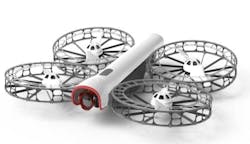AIA petitions FCC for spectrum to control unmanned aircraft systems
By David Silver, vice president, civil aviation, Aerospace Industries Association (AIA)
Unmanned aircraft systems (UAS) comprise one of the fastest growing sectors of the aerospace industry. Already being used in precision agriculture, emergency management, weather forecasting, infrastructure management and wildlife protection, UAS have the potential to reshape many businesses, if the appropriate resources are dedicated for them.
To help open this market, invigorate American innovation and position AIA as a leader in the UAS sector, we have petitioned the Federal Communications Commission (FCC) to designate spectrum for radio-line-of-sight UAS C2 operations. Our petition sets forth guidelines that will maintain and improve airspace safety and unleash growth potential for UAS.
Regulators at the FCC and industry users of spectrum should support our recommendations and set forth a firm and empowering regulatory structure that will encourage development of the multitude of benefits that UAS offer and help our industry realize its great potential to create high-skill, high-wage jobs in the United States.
But why is “spectrum” important to UAS operations? Spectrum here refers to the radio spectrum, but it’s much more than top 100 hits and talk radio. From GPS guidance and weather observation to the communications systems for our modern warfighter, or just our modern cellphones, use of spectrum to send signals is ubiquitous.
Spectrum is part of the glue that holds together modern life and is essential to the aerospace and defense industry. However, as crucial as spectrum is, there are only a limited number of frequencies that can be used. Judicious allocation of these limited bands can mean the difference between a successful mission or going back to the drawing board.
Medium to large UAS have tremendous potential not only for our national defense but in the commercial sector as well. Spectrum resources that allow the operator both to maintain control of the aircraft and to receive critical flight data – known as ‘command and control’ (C2) – are an absolute requirement for non-autonomous UAS to operate safely and efficiently in any airspace. Without much needed C2 spectrum allocations, the burgeoning UAS market faces significant obstacles to growth.
The global UAS market is highly competitive – being first to innovate, first to market and first to regulate is key to America’s leadership position for this new technology. Quick action on AIA’s petition will make the United States the first nation to implement rules and regulations that devote spectrum resources specifically for commanding and controlling UAS. Our recommendations would ensure U.S. leadership in the UAS market, position U.S. standards as the global norm and provide a competitive edge to U.S. manufacturers and workers.
Read the AIA’s petition online at http://www.aia-aerospace.org/wp-content/uploads/2018/02/AIA-Petition-for-Rulemaking-on-UAS-2018-02-08-FILED.pdf
The go-to resource for Intelligent Aerospace technology news & information:
Covering key topics
Across all market segments
Subscribe to the free Intelligent Inbox e-newsletter: http://www.intelligent-aerospace.com/subscribe.html.
Connect on social media:
Keep pace with aerospace innovation and opportunities via your favorite social media channels. Connect with Intelligent Aerospace on Twitter (@IntelligentAero), LinkedIn,Google+, and Instagram.



